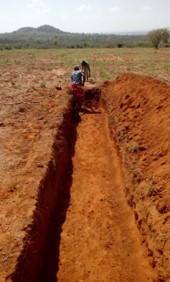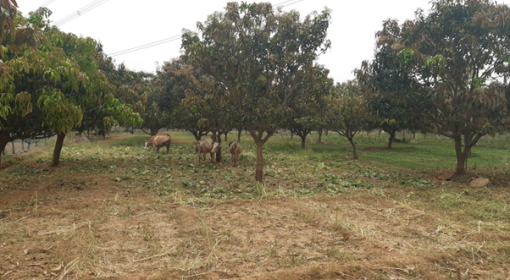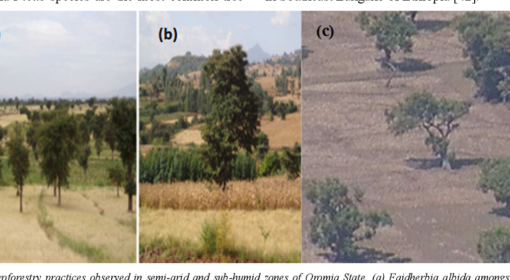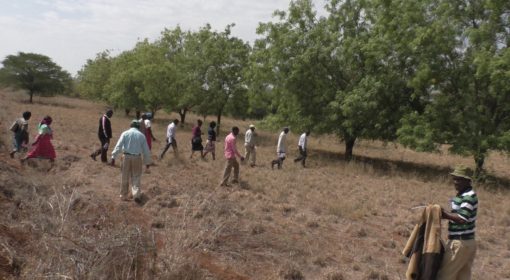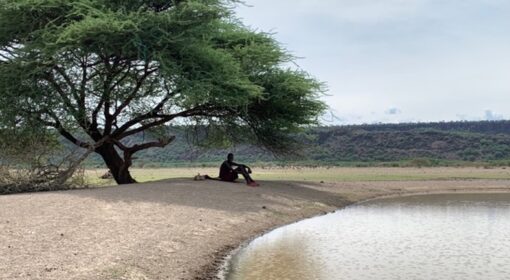Fodder production with road water harvesting in African drylands
Posted by Kevin Mganga
May 22/05/2018
Drylands provide a vital livelihood stream to people across the globe through a range of goods, products and ecosystems services. These arid and semi-arid lands (ASALs) are characteristically very fragile and are facing increased land use and land use change pressure compounded by high climate variability. These ecosystems are under threat and thought to be in various degrees of degradation. The extent and impact of land degradation remains uncertain, with some sources routinely citing that up to 70 % of the world’s drylands are ‘desertified’ while others suggest a figure of less than 17 % (Gisladottir and Stocking 2005). Land degradation, reflected not only by the reduced capacity of the land to sustainably produce ecosystem services but also its economic value, is widely recognized as one of the most serious global challenges of our time. It directly affects over 250 million people and putting some one billion people, mainly pastoralists, at risk (Wessels et al. 2007).
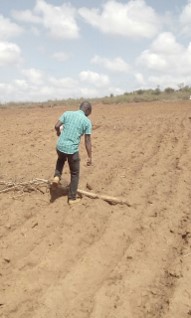
Land degradation is a problem facing most developing countries, particularly in Sub-Saharan Africa (SSA). In Africa, up to 73 % of the drylands and 268 million people (Gisladottir and Stocking 2005) are affected by desertification. Dryland ecosystems of Africa are especially susceptible to degradation because they have a poor soil structure exacerbated by scarce vegetation cover (Lal 2009). Drop in soil fertility, soil biodiversity loss and soil erosion by wind and water demonstrate degradation in semi-arid areas in Africa (Visser et al. 2007). In Kenya, land degradation in the ASALs has been extensively considered as a major environmental problem. Approximately 80 % of Kenya is affected by land degradation (Adam and Watson 2003). According to Nyangito et al. (2008), approximately 30-40 % of Kenya’s ASALs are rapidly being lost through degradation and an additional 2 % have completely been denuded. Much of the soil erosion occurs when vegetation cover is removed, as this leaves soil unprotected from water and wind. The principal degradation processes in the ASALs of Kenya are water and wind erosion, salinization, soil compaction and vegetation degradation.
Vegetation degradation in the dryland environments is a worldwide phenomenon and is recognized as an important measure of degradation over different spatial and temporal scales (Visser et al. 2007). Changes in the composition of the herbaceous vegetation cover, grasses and herbs, exemplify the short-term indicators of vegetation degradation which are reversible (Mganga et al. 2018). However, a shift in state from herbaceous to bushy dominated vegetation types is indicative of more permanent degradation (Bennett et al. 2012). Natural vegetation change from ‘excellent condition’ to ‘poor condition’ in the dryland environments triggers a subsequent but comparative increase in the dominance of unpalatable plant species over the more preferred palatable plant species (Angassa 2014; Kassahun et al. 2008). Grass reseeding has been used successfully as a means of restoring degraded drylands in Africa (Nyangito et al. 2009; Mganga et al. 2010; 2015; Opiyo et al. 2011). As a rule of thumb, the best grasses for any reseeding program are those that are native and found on range sites similar to those to be reseeded. Some of the common indigenous grasses commonly used for reseeding programs in Kenya are African foxtail grass (Cenchrus ciliaris), Bush rye grass (Enteropogon macrostachyus) and Maasai Love grass (Eragrostis superba).
Cenchrus ciliaris is native to tropical and sub-tropical Africa and one of the most drought-tolerant of perennial grasses. It is an extremely variable species, tufted (sometimes shortly rhizomatous) and persistent perennial which occurs in a wide variety of types, some of which have become reputed cultivars (Marshall et al. 2012). Numerous cultivars have been created in order to improve productivity and vigour in extreme conditions of drought, disease and frequent fires. The panicle is erect or nodding with a bur-like fascicle comprising a single spikelet or cluster spikelets, surrounded by an involucre of bristles of various lengths. Bristles are barbed and hairy, giving the fascicle an adhesive quality thus dispersed profusely by clinging to animal fur and by wind as well (Marshall et al. 2012) Its free-seeding nature can make it a major pasture component by simply spreading into relatively undisturbed native pasture from nucleus areas established by traditional methods. Cenchrus ciliaris has a deep strong fibrous root system that exceeds 2m. It is a particularly aggressive grass, by virtue of its extensive root system competing with associated species for water and nutrients. It also appears to be allelopathic (Mganga et al. 2015).
Cenchrus ciliaris occurs in the wild on sandy soils, but is also well adapted to deep, freely draining sandy loams, loams, clay loams and red earth soils. It has been recommended for reseeding areas receiving an annual rainfall of 350-900mm. Whole seeds of this species have been sown to result in better grass stands than when hulled seeds are used (Opiyo et al. 2011). Seeds of C. ciliaris germinate better after pre-drying for 10 days at 40ºC than pre-chilling for the same period at 5ºC (Hussey and Bashaw 1996). Degraded pastures in the drylands are reseeded with C. ciliaris to enhance productivity, prolong grazing period and increase carrying capacity. Furthermore, it is a palatable and nutritious grass species, highly nutritious forage for livestock and recovers well from grazing (Marshall et al. 2012). It produces reasonable quality hay when cut in the early flowering stage, yielding up to 2 500 kg/ha per cut with a protein content of 6-10% of dry matter (Koech et al. 2016).
Enteropogon macrostachyus is native species to Africa. It is a widely distributed perennial grass species very common in arid and semi-arid areas where it grows in bush, forest edges and to a lesser extent in open grassland (Opiyo et al. 2011). It is a tufted perennial suitable for reseeding rock slopes or bushland. It has proved an excellent grass for reseeding African drylands under moderately dry conditions. This species has been tried with moderate success for reseeding denuded pastoral land in Kenya (Mganga et al. 2015) under annual rainfall of 550-800mm. Enteropogon macrostachyus is a good grass for arid and semi-arid ecosystems because it is drought resistant. This species has erected culms of 30-100cm high. Leaf sheaths are without a keel. Surface of the sheath and outer margins are glabrous. Leaf blades are narrow and flat, approximately 10-60cm long and 1.5-10mm wide. Depending on the environmental conditions E. macrostachyus may be leafy or stemmy. Although stemmy, it is drought resistant and provides useful grazing for grazing herbivores. Previous studies (e.g. Koech et al. 2016), have shown E. macrostachyus to have a crude protein and crude fibre percentages of 5.2% and 28% respectively. In tropical Africa, E. macrostachyus occurs naturally in open rangelands and rocky outcrops in semi-arid environments at an altitude ranging between 300-1600m above sea level. The species occurs in areas receiving around 600mm of rainfall per annum. It is a very good seeder and seed can be collected rapidly by cutting the seed-heads or stripping the heads by hand. It lends itself easily to mechanical harvesting. The seeds germinate readily and grow vigorously. It is palatable thus its re-introduction in degenerated swards is of obvious value to grazers (Opiyo et al. 2011).
Eragrostis superba derives its scientific name from both Greek and Latin words. Eragrostis comes from the Greek words Eros meaning love and this possibly refers to the heart shaped spikelets; and Agrostis meaning grass. The species name superba is the Latin for splendid, probably descriptive of the spikelets. Eragrostis superba occurs naturally in South Africa and northwards throughout East Africa to Sudan. It is wide spread in the semi-arid areas of East Africa and is very common in various vegetation types mainly grassland and savanna types, rocky and sandy areas throughout its ecological range. Eragrostis superba is a tufted perennial 20-120cm high with a high shoot/root ratio (Opiyo et al. 2011) which is a disadvantage during drought periods but is advantaged by having deep root system which go as far as 2.2m with 73% of the roots limited to the upper 0.4m from the soil surface, which enable the grass to make full use of light showers of rain (Opiyo et al. 2011; Mganga et al. 2010; 2015). It is a moderate tiller with a poor regrowth ability compared to C. ciliaris and C. roxburghiana. Eragrostis superba grows in disturbed places and thus has been used successfully for reseeding denuded and pastoral drylands and soil erosion control in dryland Africa (Nyangito et al. 2009; Mganga et al. 2010; 2015; Opiyo et al. 2011) because of it has excellent establishment characteristics. It has been successful in the semi-arid areas of East Africa particularly in eco-climatic zone VI where mean annual rainfall ranges between 500-900mm. Eragrostis superba occurs at an altitude of 0-2000m above sea level. Eragrostis superba, along with C. ciliaris have been the basis of the seed mixtures used for large-scale reseeding programmes in ASALs in Kenya.
Eragrostis superba is a quick growing species and shows green vegetative growth almost throughout the year and has good drought tolerance. It is very palatable when young. Depending on the soil types and other environmental conditions, chemical and digestibility analyses indicate that the grass has between 5-12% crude protein (%CP) in the dry matter at an early-flowering stage with 25-35% crude fibre (%CF) (Koech et al. 2016). Wasonga et al. (2003) demonstrated that pastoral communities in Kenya have identified E. superba as one of the grass species suitable for fattening and improving the condition of their livestock herd. E. superba grows very easily from seeds which are in the form of a small, plump grain, which are particularly susceptible to insect damage. The grass seeds can be collected easily from open grassland or at roadsides by stripping the ripe panicles. Mature spikelets, each with numerous florets, detach easily with the caryopses enclosed. The grass can be established in gravely, sandy, loamy or clay soils. However, it does best in sandy soils but occurs also on clay loams and clays. The species has a high tolerance to salinity and alkalinity and can also be found on termite mounds common in the African drylands.
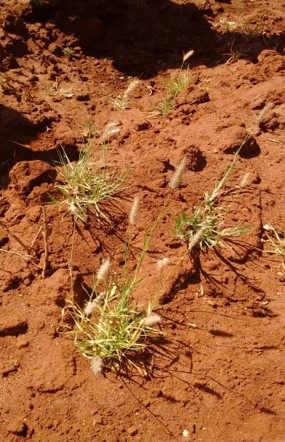
Plant attributes, morphometric and soil hydrological properties as influenced by common indigenous pastures used in reseeding programs in dryland Africa; African foxtail grass (Cenchrus ciliaris), Bush rye grass (Enteropogon macrostachyus) and Maasai Love grass (Eragrostis superba) are shown in Tables 1 and 2 below.
Table 1: Plant attributes of some indigenous grass species used for reseeding programmes
| Grass species | Biomass yield (kg/ha) | Plant frequency (%) | Plant density (plants m-2) | Basal cover (%) | Seed production (kg/ha) |
| C. ciliaris | 1026.6±55a | 44.4±19.63a | 7±5.23a | 30±26.44a | 145±13a |
| E. macrostachyus | 744.0±28b | 72.3±25.43b | 36±2.1b | 54±19.29b | 56±25b |
| E. superba | 896.5±44c | 38.7±9.82a | 5±6.25a | 23±15.44a | 119±17c |
Column means followed by different letters are significantly different at P < 0.05
Table 2: Infiltration capacity (cm3) in relation to grass stubble heights (cm)
| Stubble height (cm) | Infiltration capacity (cm3) | ||
| Cenchrus ciliaris | Enteropogon macrostachyus | Eragrostis superba | |
| 0 | 1047a ± 0 | 1047a ± 0 | 1047a ± 0 |
| 20 | 1530b ± 65.57 | 1413c ± 32.15 | 1067d ± 30.55 |
| 40 | 1883c ± 25.17 | 1760d ± 55.68 | 1513b ± 70.95 |
Column and row means followed by different letters are significantly different at P < 0.05
Reseeding programs aim at improving existing ground cover and pasture biomass to an extent or in a manner not possible by grazing management. This can be accomplished by over-sowing into existing vegetation with a superior species, reseeding a denuded land and establishing a completely new pasture, with or without the aid of irrigation. Flood based irrigation and road water harvesting are two viable and low-entry methods to boost fodder production in drylands. A high soil moisture content and prolonged plant growth can be ensured by spreading water on the field or by capturing it through trenches. These will allow water time to infiltrate slowly, this water will move in both vertical and lateral directions, thus recharging groundwater and soil moisture. Systematically introducing the spreading of short term floods from ephemeral rivers and from road drainage combined with water retention in trenches will lead to increase of soil moisture levels. This can revitalize drylands into a highly productive production system – in terms of return to labour. Growing fodder with flood and road drainage water has several advantages: (1) it turns a threat (flood/drainage water) into an asset; (2) it reliefs the pressure on the dry rangelands and creates an economically rewarding production system, and (3) it requires almost no land preparation and hence it can also be applied in areas that are short in skills and labour.
